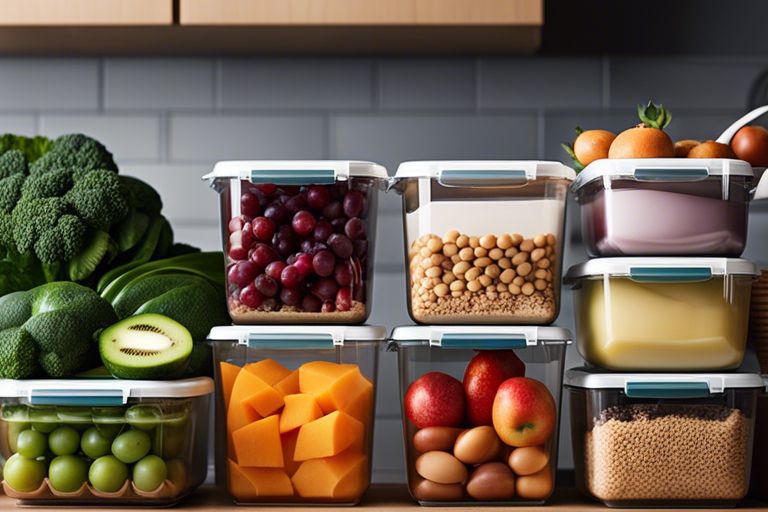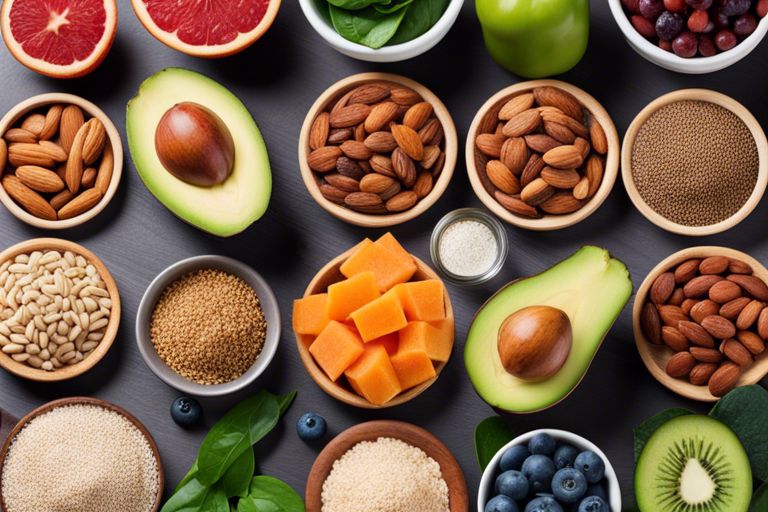There’s no denying the benefits of meal prepping – it saves you time, money, and ensures you make healthy choices throughout the week. To meal prep like a pro, start by planning your meals, creating a grocery list, and dedicating a few hours to prep on weekend. Invest in quality storage containers to keep your meals fresh and organized. With these tips, you’ll set yourself up for a week of healthy eating success.
1. Plan your meals and snacks for the week ahead.
2. Make a detailed shopping list of all necessary ingredients.
3. Set aside a few hours to cook and prepare meals.
4. Use containers to portion out meals for easy grab-and-go.
5. Store meals in the fridge or freezer, labeling each container.
6. Enjoy healthy, delicious meals throughout the week!
Understanding Your Dietary Needs
The first step in meal prepping like a pro is understanding your dietary needs. This involves assessing your caloric requirements, identifying any food allergies or intolerances you may have, and considering your lifestyle and preferences.
Assessing Your Caloric Requirements
Now, to determine your caloric needs, you can use online calculators or consult with a nutritionist. Calculating your Basal Metabolic Rate (BMR) and factoring in your activity level will give you an estimate of how many calories you need per day to maintain, lose, or gain weight.
Identifying Food Allergies and Intolerances
Identifying any food allergies or intolerances you have is crucial to meal prepping successfully. Symptoms of food sensitivities can range from mild bloating to severe allergic reactions. By knowing what foods to avoid, you can plan your meals accordingly.
Allergies: If you suspect you have a food allergy or intolerance, consider keeping a food diary to track your symptoms after eating certain foods. If you notice a pattern of discomfort or reactions, consult with a healthcare professional for testing and guidance.
Considering Your Lifestyle and Preferences
Understanding your lifestyle and food preferences will help you create a meal prep plan that you can stick to. Whether you follow a specific diet like vegetarian or keto, or have a busy schedule that requires quick and easy meals, tailoring your prep to fit your lifestyle is key to success.
Food: You may also want to consider your cooking skills, time constraints, and budget when planning your meals. Investing in versatile ingredients and kitchen tools can make the meal prep process more efficient and enjoyable for you.
Planning Your Meals
Setting Realistic Goals and Expectations
Assuming you are new to meal prepping, it is important to start with realistic goals and expectations. Look for inspiration from resources like 60 Healthy Meal Prep Ideas to help you understand what a week of meals could look like. By setting achievable goals, you are more likely to stick with your meal prep plan and avoid feeling overwhelmed.
Choosing Healthy and Balanced Recipes
You want to select recipes that are both healthy and balanced. Opt for a variety of proteins, whole grains, and colorful vegetables to ensure you are getting a range of nutrients in your meals. Consider incorporating different cooking methods like roasting, steaming, or sautéing to keep your meals interesting and flavorful.
Recipes that focus on whole foods and minimize processed ingredients are ideal for meal prep. Choose dishes that can easily be portioned out into containers and reheated throughout the week. Additionally, consider recipes that use similar ingredients to streamline your grocery shopping and meal prep process.
Creating a Meal Prep Schedule
Goals for creating a meal prep schedule include allocating a specific time each week for planning, grocery shopping, cooking, and assembling your meals. By dedicating a few hours to meal prep, you can save time during the week and ensure that you have healthy options readily available. Start with simple recipes and gradually build up to more complex meal preps as you become more comfortable with the process.
Your meal prep schedule should be tailored to your lifestyle and preferences. Whether you prefer to prepare all meals for the week in one day or split the prep work into multiple sessions, find a routine that works best for you. Remember to factor in storage options and meal variety to keep things exciting and prevent meal fatigue.
Grocery Shopping Like a Pro
All A Beginner’s Guide on How to Meal Prep for the Week starts with efficient grocery shopping. When you’re meal prepping for the week, it’s crucial to plan ahead and make a detailed grocery list to ensure you have all the necessary ingredients. By following a few simple steps, you can streamline your grocery shopping process and set yourself up for a successful week of healthy eating.
Making a Grocery List Based on Your Meal Plan
An important step in successful meal prep is creating a detailed grocery list based on your meal plan. Take inventory of what you already have in your pantry and fridge, then make a list of all the ingredients you’ll need for your planned meals. Organize your list by categories like produce, proteins, grains, and dairy to make navigating the store easier. This will help you avoid forgetting any crucial ingredients and save you time during your shopping trip.
Navigating the Grocery Store Efficiently
There’s no denying that navigating a crowded grocery store can be overwhelming, but with a bit of strategy, you can make the process much smoother. Start by sticking to the perimeter of the store where you’ll find fresh produce, meats, dairy, and whole foods. This will help you avoid the temptation of processed and unhealthy foods that are often found in the aisles. Additionally, try to go shopping during off-peak hours to avoid long lines and crowded aisles.
Based on your well-organized grocery list, move through the store efficiently, checking off items as you go. Don’t forget to compare prices and opt for store brands or bulk options when possible to save money. Remember to stay focused on your list and avoid impulse purchases to stay within your budget and stick to your meal prep plan.
Stocking Up on Pantry Staples and Essentials
Grocery shopping for meal prep also involves stocking up on pantry staples and importants that will help you create a variety of delicious and nutritious meals throughout the week. Make sure to have a good supply of items like whole grains, canned beans, spices, herbs, healthy oils, and condiments. These staples will serve as the foundation for many of your meals and can add flavor and variety to your dishes.
Store these pantry staples in a well-organized manner so they are easily accessible when you’re prepping your meals. **Having a well-stocked pantry can save you time and effort in the kitchen and ensure that you always have the basics on hand to whip up a healthy meal.** Consider investing in airtight containers to store items like grains, nuts, and seeds to keep them fresh and prevent pantry pests.
Essential Kitchen Tools and Equipment
Many kitchen tools and equipment can make your meal prep process much smoother and more efficient. To ensure you have everything you need for a successful week of healthy eating, it’s necessary to stock up on the right items.
Must-Have Cookware and Utensils
Now, make sure you have a good set of non-stick pots and pans, a sharp set of knives, cutting boards, mixing bowls, measuring cups and spoons, and cooking utensils like spatulas and tongs. These basic items will help you prepare a variety of dishes with ease.
Time-Saving Gadgets and Appliances
TimeSaving, investing in time-saving gadgets like a food processor, blender, slow cooker, and Instant Pot can significantly reduce your meal prep time. These appliances can help you chop, blend, and cook ingredients quickly, allowing you to multitask and save time in the kitchen.
Understanding the functionality of these gadgets and appliances can revolutionize your meal prep experience. The food processor can quickly chop veggies, the blender can make smoothies in seconds, the slow cooker can simmer a hearty stew while you work, and the Instant Pot can speed up cooking times for grains and proteins.
Storage Containers and Meal Prep Accessories
The key to successful meal prep is having a good collection of storage containers in various sizes. These containers will help you portion out your meals, store leftovers, and keep your food fresh throughout the week. Additionally, investing in meal prep accessories like reusable silicone bags, mason jars, and insulated lunch bags can make on-the-go eating a breeze.
Another necessary item to consider is a quality set of reusable ice packs. These ice packs can be used in your lunch bag to keep your meals fresh and safe to eat, especially if you don’t have access to a fridge during the day.
Meal Prep Fundamentals
Despite your busy schedule, meal prepping can help you stay on track with your health goals and save time during the week. By cooking in bulk and preparing key ingredients ahead of time, you can easily put together nutritious meals in a matter of minutes. Here are some meal prep fundamentals to get you started on your journey to healthy eating.
Cooking Proteins in Bulk
Cooking proteins in bulk is a key step in meal prepping. By cooking proteins like chicken, beef, or tofu in large batches, you can have a versatile base for various meals throughout the week. Simply season your proteins with your favorite herbs and spices, then bake, grill, or sauté them until fully cooked. Once cooled, you can portion them out into meal-sized containers and store them in the fridge or freezer for later use.
Roasting Vegetables for Maximum Flavor
With roasting, you can bring out the natural flavors of vegetables and create delicious side dishes for your meals. Simply toss your chosen vegetables in olive oil, season with salt, pepper, and herbs, then spread them out on a baking sheet. Roast them in the oven until they are tender and caramelized. You can roast a variety of vegetables such as broccoli, sweet potatoes, and bell peppers to add color and nutrients to your meals.
Aim to include a variety of colors in your roasted vegetables to ensure you are getting a wide range of nutrients. Different colored vegetables offer different vitamins and minerals, so having a colorful mix on your plate is not only visually appealing but also beneficial for your health.
Preparing Whole Grains and Legumes
If you want to add fiber and protein to your meals, preparing whole grains and legumes in advance is necessary. Cook up a batch of quinoa, brown rice, lentils, or chickpeas to have on hand for quick and easy meal assembly. These ingredients can be used as a base for grain bowls, salads, or wraps, adding texture and nutrients to your meals.
If you choose to cook whole grains and legumes from scratch, make sure to rinse them thoroughly before cooking to remove any dirt or debris. You can also invest in a rice cooker or Instant Pot to streamline the cooking process and ensure perfectly cooked grains every time.
Tips for Portion Control and Meal Assembly
Not sure how to properly portion your meals for the week ahead? Here are some tips to help you maintain portion control and efficiently assemble your meals.
Measuring and Weighing Ingredients Accurately
The key to portion control starts with accurately measuring and weighing your ingredients. Use measuring cups and a kitchen scale to ensure you are using the correct amount of each ingredient in your meals. This will help you avoid overeating and keep your portions consistent throughout the week.
Assembling Meals in Advance
For efficient meal prep, it’s imperative to assemble your meals in advance. This means having all your ingredients prepped and ready to go before you start cooking. You can save time by chopping vegetables, marinating proteins, and portioning out grains ahead of time. This way, when it comes to cooking and assembling your meals, everything will be organized and ready for you to put together.
Another benefit of preparing your meals in advance is that you can mix and match ingredients to create a variety of meals throughout the week. By having your components ready, you can easily switch up your meals by combining different proteins, vegetables, and grains to keep things interesting.
Labeling and Storing Meals for Easy Reheating
For easy reheating and meal organization, be sure to label your meals before storing them in the fridge or freezer. Use clear containers and label them with the date and contents of each meal. This way, you can easily grab a meal when you need it without having to guess what’s inside. Additionally, storing your meals properly will help maintain freshness and ensure they last throughout the week.
Another tip is to portion out individual servings of your meals before storing them. This way, you can grab a single serving and heat it up without having to defrost the entire batch. This not only makes mealtime more convenient but also helps you control portion sizes and avoid overeating.
Factors to Consider for Healthy Meal Prep
Now that you’ve decided to launch on a journey of healthy meal prepping, there are a few important factors to consider to ensure that your meals are nutritious and balanced. By paying attention to these key elements, you can set yourself up for a week of successful and healthy eating.
- Macronutrient Balance and Ratios: Even if you are meal prepping for the entire week, it’s important to make sure that each meal contains a good balance of protein, carbohydrates, and healthy fats. These macronutrients play crucial roles in keeping your body functioning optimally and help you feel satisfied after each meal. For guidance on appropriate macronutrient ratios, you can refer to the Meal Prep Guide – The Nutrition Source.
- Hydration and Electrolyte Balance: Even with all your meal prep efforts, don’t forget the importance of staying hydrated. Hydration is key to maintaining optimal bodily functions, and electrolytes play a crucial role in ensuring that your body’s fluids are balanced. Including foods rich in electrolytes like potassium and magnesium can help you stay properly hydrated throughout the week.
Hydration and Electrolyte Balance
With all the focus on meal prep, it’s easy to overlook your hydration needs. However, staying hydrated is crucial for overall health and well-being. When you are meal prepping, make sure to include water-rich foods like fruits and vegetables in your meals to help meet your fluid needs. Additionally, consider adding a squeeze of lemon or lime to your water for a refreshing and electrolyte-boosting drink.
Factors to Consider for Healthy Meal Prep
If you’re aiming to prepare meals in advance for the week, it’s important to follow food safety and handling guidelines. This ensures that your meals stay safe to eat throughout the week. Properly storing cooked foods, using separate cutting boards for raw meat and vegetables, and reheating leftovers to the correct temperature are all important steps in maintaining food safety during meal prep.
Food safety is paramount when it comes to meal prep, as it can prevent foodborne illnesses and keep you healthy. By following the 4 C’s of food safety – cleaning, cooking, chilling, and cross-contamination prevention – you can ensure that your meals are safe to consume. Bear in mind, your health is too precious to compromise on safe food practices.
Meal Prep for Specific Diets
Gluten-Free and Low-Carb Meal Prep
On your journey to meal prepping for a gluten-free and low-carb diet, focus on incorporating nutrient-dense foods that are naturally free of gluten and low in carbohydrates. Stock up on fresh vegetables, lean proteins like chicken, fish, and tofu, and healthy fats such as avocados and nuts.
Vegan and Vegetarian Meal Prep Options
Options for vegan and vegetarian meal prep are abundant and delicious. Incorporate a variety of plant-based proteins like beans, lentils, quinoa, and tempeh into your meals. Include a colorful array of fruits and vegetables to ensure you are getting a wide range of necessary nutrients in your diet.
Understanding the nutritional needs of a vegan or vegetarian diet is necessary for successful meal prepping. Make sure you are including sources of vitamin B12, iron, and omega-3 fatty acids in your meals to support your overall health.
Meal Prep for Special Dietary Needs (e.g. Keto, Paleo)
For specific dietary needs such as Keto or Paleo, meal prepping can be tailored to fit these lifestyles. Focus on high-fat, low-carb options for Keto, including avocado, coconut oil, and grass-fed meats. For Paleo, emphasize wholefoods like fruits, vegetables, lean meats, nuts, and seeds.
Specific dietary requirements like Keto or Paleo may require additional planning and preparation, but they can be easily incorporated into your meal prepping routine with the right guidance and recipes.
Time-Saving Hacks and Shortcuts
After you have mastered the art of meal prepping, it’s time to streamline the process even more with time-saving hacks and shortcuts. These tips will help you save time and energy in the kitchen while ensuring that you still have delicious and nutritious meals ready to go throughout the week.
One-Pot Wonders and Sheet Pan Recipes
Some of the easiest and quickest meals to prepare are one-pot wonders and sheet pan recipes. With these dishes, you can simply toss all your ingredients onto a single pot or pan, pop it in the oven, and let it do all the work for you. Not only does this save you time on prep work and cleanup, but it also allows for easy portioning and storage once the meal is ready.
Using Leftovers and Repurposing Ingredients
Even after a week of diligent meal prepping, you may find yourself with leftovers or extra ingredients that you didn’t use up. Instead of letting them go to waste, **you can repurpose these ingredients into entirely new meals**. For example, leftover grilled chicken can be shredded and used in tacos, salads, or wraps. Extra vegetables can be blended into soups or stir-fries. Get creative with your leftovers to **maximize your ingredients and minimize food waste**.
Recipes
Meal Prep in Under 30 Minutes
Time-saving hacks are crucial when it comes to meal prepping, especially if you have a busy schedule. **Meal prepping in under 30 minutes** is not only possible but can be quite simple with the right recipes and strategies. Focus on quick-cooking grains like quinoa or couscous, utilize precooked proteins like rotisserie chicken or canned beans, and rely on pre-cut vegetables to cut down on prep time. With a bit of planning and organization, **you can have a week’s worth of meals ready in less time than it takes to watch your favorite TV show**.
Time-Saving
This kind of meal prepping is perfect for those weeks when you have limited time but still want to prioritize **healthy eating**. By dedicating just half an hour to meal prepping, **you can set yourself up for success and avoid the temptation of unhealthy fast food options**. With a few time-saving tricks up your sleeve, **you can make nutritious eating a breeze even on your busiest days**.
Overcoming Common Meal Prep Challenges
Dealing with Food Boredom and Burnout
Overcoming food boredom and burnout during meal prep is crucial to staying on track with your healthy eating goals. To avoid getting tired of eating the same meals every day, try to incorporate a variety of flavors and ingredients into your meal prep rotation. Mix up your proteins, grains, and vegetables each week to keep things interesting. Additionally, consider trying new recipes or cuisines to keep your taste buds excited.
Managing Meal Prep Stress and Overwhelm
Dealing with stress and overwhelm during meal prep can be challenging, but it’s important to remember that meal prep is meant to make your life easier, not add to your stress. To manage this, start by planning your meals and grocery shopping ahead of time. Break down your meal prep tasks into smaller, manageable steps and use tools like a slow cooker or instant pot to save time in the kitchen.
Note, it’s okay to take shortcuts like buying pre-cut vegetables or using frozen ingredients to make the process less daunting. Don’t be afraid to ask for help from family members or roommates to share the workload and make meal prep a team effort.
Staying Motivated and Accountable
Keeping up with meal prep can be tough, but staying motivated and holding yourself accountable is key to long-term success. To stay on track, set specific goals for your meals and prep sessions. Whether it’s prepping a certain number of meals each week or trying a new healthy recipe, having goals will help you stay focused.
Additionally, find a meal prep buddy or support group to keep you motivated and accountable. Share your progress, struggles, and successes with someone who can cheer you on and help you stay committed to your healthy eating goals.
Meal Prep on a Budget
Many people believe that meal prepping is expensive, but with some strategic planning, you can meal prep like a pro without breaking the bank. Here are some tips to help you meal prep on a budget.
Affordable Protein Sources and Staples
Protein: When trying to save money on meal prep, opt for affordable protein sources like beans, lentils, eggs, and canned tuna or chicken. These options are not only budget-friendly but also versatile and can be used in a variety of recipes.
Shopping Sales and Stocking Up
Prep: Keep an eye out for sales and discounts on your favorite staple items like rice, pasta, frozen vegetables, and canned goods. Buying in bulk when these items are on sale can help you save money in the long run and ensure you always have key ingredients on hand for your meal prepping sessions.
When shopping sales, consider stocking up on non-perishable items like grains and canned goods that have a long shelf life. This way, you can always have a variety of ingredients to choose from when planning your meals without worrying about them spoiling quickly.
Meal Prep for One or for a Crowd
Sales: If you’re meal prepping for one person, consider buying family-sized packs of protein like chicken breasts or ground turkey when they are on sale. You can portion them out and freeze individual servings for later use, saving you time and money in the long run. For larger families or groups, look for bulk discounts on ingredients like meats, grains, and produce to help you stretch your budget further.
It may require a bit more planning and organization, but with these budget-friendly meal prep tips, you can nourish yourself and your loved ones with healthy and delicious meals without overspending. Start incorporating these strategies into your meal prepping routine and watch your savings grow while enjoying nutritious homemade meals throughout the week.
Meal Prep for Busy Schedules
Unlike regular meal prepping, when you have a busy schedule, you need to be strategic and efficient with your meal prep. Here are some tips to help you stay on track with your healthy eating even when you’re juggling a hectic routine.
Meal Prep for Early Risers and Night Owls
To accommodate your early mornings or late nights, consider preparing your meals at a time that aligns with your natural energy levels. If you’re an early riser, utilize the quiet morning hours to cook and pack your meals for the day. If you’re a night owl, you can meal prep in the evening to ensure you have healthy options ready to go for the next day. Adjust your meal prep schedule to fit your body clock so that you can stay consistent and motivated.
Prepping Meals on the Go
Schedules can get overwhelmingly busy, but that doesn’t mean you have to sacrifice your nutrition. When you’re constantly on the move, opt for quick and easy meal prep options like salads in mason jars, pre-portioned snacks, or meal replacement shakes. Having portable meal options on hand will help you stay on track with your healthy eating goals, even on the busiest of days.
Meal prepping for on-the-go situations doesn’t have to be time-consuming or complicated. With a little planning and the right tools, you can whip up nutritious meals and snacks that you can easily grab and take with you wherever you need to go.
Meal Prep for Travel and Commuting
One way to tackle meal prep when you have a busy travel schedule or long commutes is to prep meals that are easy to transport and require minimal refrigeration or heating. Consider options like wraps, sandwiches, salads in a container, or bento box-style meals that can be enjoyed cold or at room temperature.
When you’re on the go, having pre-prepped meals ready to eat can save you time and money, as well as help you make healthier choices while traveling or commuting. You can avoid the temptation of fast food or unhealthy snacks by having your nutritious meals on hand.
Advanced Meal Prep Techniques
Many advanced meal prep techniques can take your meal prepping game to the next level. Here are some advanced methods you can incorporate into your meal prep routine:
- Sous Vide Cooking and Precision Temperature Control
| Sous Vide Cooking | Precision Temperature Control |
| Under vacuum, cook food in a water bath at a precise temperature. | Ensures consistent results and locks in flavors and nutrients. |
Sous Vide Cooking and Precision Temperature Control
Any home cook can elevate their meal prep by using a sous vide machine. This technique involves cooking food in vacuum-sealed bags in a water bath at a precise temperature. Sous vide cooking ensures consistent results and helps to retain the flavors and nutrients in your ingredients.
Fermentation and Pickling for Gut Health
The art of fermentation and pickling can not only add depth of flavor to your dishes but also boost your gut health. The fermentation process involves beneficial bacteria breaking down sugars and starches in food, creating gut-friendly probiotics that support digestion and overall well-being.
The more variety of fermented foods you include in your diet, the better diversity of probiotics you can introduce to your gut, promoting a healthy microbiome.
Dehydrating and Freeze-Drying for Long-Term Storage
Dehydration and freeze-drying are techniques that can extend the shelf life of your ingredients for long-term storage. By removing moisture from food, you can prevent the growth of bacteria, mold, and yeast, allowing your ingredients to stay fresh for an extended period of time.
Fermentation can also play a role in preserving foods while adding unique flavors. By fermenting vegetables or fruits, you can create tangy pickles or kimchi that can last for months in the fridge, providing you with delicious and healthy condiments.
Final Words
Upon reflecting on how to meal prep like a pro for a week of healthy eating, you now have all the tools and knowledge to successfully plan and prepare your meals in advance. By following these steps and tips, you can save time, money, and energy throughout the week while ensuring that you are eating nutritious and balanced meals.
Be mindful of, meal prepping is all about finding what works best for you and your lifestyle. It may take some trial and error to figure out your preferences, but with practice, you will become more efficient and proficient in planning your meals. Stay consistent, stay organized, and most importantly, enjoy the benefits of having healthy, home-cooked meals readily available to you each day.














